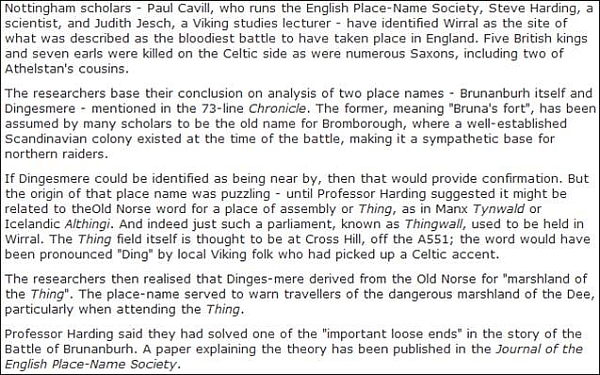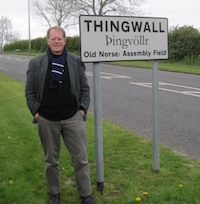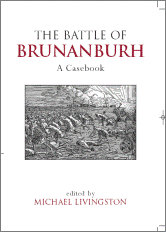
from The Independent, 8th December 2004 Text for audio link
BATTLE OF BRUNANBURH AD937
The Battle of Brunanburh was one of the most defining battles in the history of the British Isles and, as described by BBC Broadcaster Neil Oliver in History of Scotland it determined whether Britain would become one imperial power or stay as separate identities. Although the Northern Alliance of Scots, Strathclyde British and Norsemen from Ireland lost the battle against a combined Anglo-Saxon army from Mercia and Wessex - with heavy losses on both sides - the strong resistance proved decisive in what was to follow.
The Battle of Brunanburh is recorded as a contemporary (or near contemporary) poem in the Anglo Saxon Chronicle, and almost certainly took place on Wirral. Compelling arguments had earlier been made for other locations, notably in Lancashire, Yorkshire, Lincolnshire, Northants and SW Scotland. However the weight of scholarly opinion is now heavily on Wirral – the debate now seems to be where on Wirral – and how did they get there. And internationally respected author Bernard Cornwell appears to have little doubt the battle took place on Wirral as is clear from his new novel The Empty Throne:

The Wirral peninsula and Chester had not long earlier witnessed another major battle between “the armies of the Norsemen and the Danes” and the Mercian English – AD907. Chester was also the place where the Anglo Saxons had one of their earlier crushing and most significant victories against the British - AD613. Brunanburh was the old name until about 1732 for Bromborough. The poem also gives the location of the coastal point of escape as Dingesmere – which has now been satisfactorily explained as the “Things – mere or – marr”, the wetland or marshland associated with the Thing – the Viking parliament, at Thingwall on Wirral (see cutting from the Independent above).
The Anglo-Saxon poem, translated from the Old English by Hamer, reads as follows (see Campbell, A. The Battle of Brunanburh, London 1938 and Hamer, R., London 1938 and Hamer, R. A Choice of Anglo-Saxon Verse, Selected, with an Introduction and a Parallel verse translation, Faber and Faber 1970)
King Athelstan, the lord of warriors,
Patron of heroes, and his brother too,
Prince Edmund, won themselves eternal glory
In battle with the edges of their swords
Round Brunanburh; they broke the wall of shields,
The sons of Edward with their well-forged swords
Slashed at the linden-shields; such was their nature
From boyhood that in battle they had often
Fought for their land, its treasures and its homes,
Against all enemies. Their foes fell dead,
The Scottish soldiers and their pirate host
Were doomed to perish; and with blood of men
The field was darkened from the time the sun
Rose at the break of day, the glorious star,
God the eternal Lord's bright candle passed
Across the land, until this noble creature
Sank to its resting-place. There many men
Lay slain by spears, and northern warriors
Shot down despite their shields, and Scotsmen too,
Weary, with battle sated. The West Saxons
Throughout the whole long passing of the day
Pressed on in troops behind the hostile people,
Hewed fiercely from the rear the fleeing host
With well-ground swords. The Mercians refused
Hard battle-play to none among the fighters
Who came with Anlaf over rolling seas,
Bringing invasion to this land by ship,
Destined to die in battle. Five young kings
Lay dead upon the battlefield, by swords
Sent to their final sleep; and likewise seven
Of Anlaf's earls, and countless of his host,
Both Scots and seamen. There the Norsemen's chief
Was put to flight, and driven by dire need
With a small retinue to seek his ship.
The ship pressed out to sea, the king departed
Onto the yellow flood and saved his life.
Likewise the wise old Constantinus came,
The veteran, to his northern native land
By flight; he had no reason to exult
In that encounter; for he lost there friends
And was deprived of kinsmen in the strife
Upon that battlefield, and left his son
Destroyed by wounds on that grim place of slaughter,
The young man in the fight. The grey-haired man
Had little cause to boast about that battle,
The sly old soldier, any more than Anlaf;
They could not with their remnant laugh and claim
That they were better in warlike deeds
When banners met upon the battlefield,
Spears clashed and heroes greeted one another,
Weapons contended, when they played at war
With Edward’s sons upon the place of carnage.
The Norsemen left them in their well-nailed ships,
The sad survivors of the darts, on Dingesmere
Over the deep sea back they went to Dublin
To Ireland they returned with shameful hearts.
The brothers also both went home together,
The king and prince returned to their own country,
The land of Wessex, triumphing in war.
They left behind corpses for the dark
Black-coated raven, horny beaked to enjoy,
And for the eagle, white-backed and dun-coated,
The greedy war-hawk, and that grey wild beast
The forest wolf. Nor has there on this island
Been ever yet a greater number slain,
Killed by the edges of the sword before
this time,as books make known to us, and old
And learned scholars, after hither came
The Angles and the Saxons from the east
Over the broad sea sought the land of Britain,
Proud warmakers. Victorious warriors,
Conquered the Welsh, and so obtained this land.
THE CONNECTION DINGESMERE = THINGS MERE?
 This connection was made 3rd April 2004. Steve Harding - who made this connection - says the following: "I remember pausing to stare at a slide at a talk I gave – on Brunanburh – at the Thurstaston Visitor Centre, 3rd April 2004. It was a 1732 slide of Wirral showing "Tingwall" and "Brunburgh" close by. I said to myself “hang on, this has been staring us all in the face for all these years and Dodgson and everyone has missed it!” – and made the connection. I rang Dr. Paul Cavill (English Place Names Society) the following Monday with my suggestion saying surely it was too obvious to be true & he said “well actually Steve you may be right”. We both worked on a paper "Revisiting Dingesmere" in conjunction with another colleague Dr. Judith Jesch, and this was published in October 2004 by the Journal of the English Place Name Society. The Revisiting Dingesmere article concluded by placing the “Things mere” as either the Irish Sea, the Dee Estuary or wetland at the coast: “We would like to suggest that the ding of dinges mere in the Old English poem of Brunanburh refers to the þing of Thingwall. There can be little question that the mere refers to a water feature, and we further suggest that the name refers to water overlooked or controlled by, or associated with the þing. This might be the Dee Estuary and the Irish Sea. But the name probably derives ultimately from the hybrid Norse-OE þings-mere ‘wetland by the thing’, or possibly from a pure Norse compound, þings-marr ‘marshland by the thing’. In our view this name was spoken with a Gaelic inflection and heard by a speaker of English”. Steve says “So my original idea, backed up by Paul’s and Judith’s expert contributions, seems to have solved the mystery! I thought of the Thingwall most nearest the only known definite Brunanburh place name as the most likely – the Thingwall on Wirral, and that is still the case, although of course this is open to correction! I am well aware there are 3 other known Thingwall’s in the Irish Sea region my suggestion could also possibly apply to: Thingwall Hall in SW Lancs, Tynwald in the Isle of Man or Tinwald in Dumfriesshire. If it turned out that my suggestion of “the Things mere” actually applied to Tynwald or Thingwall Hall, rather than Thingwall on Wirral, that would still be perfectly consistent with a Wirral location for the battle. If someone proved it was Tinwell in Dumfriesshire or another Thingwall type of place name – if one ever existed – near the North Sea coast however it would certainly be less likely! I pointed this out in correspondence with colleague and distinguished Historian Michael Wood in November 2010, who favours a Yorkshire location for the battle. Maybe - although unlikely - Dingesmere refers to more than one Thing, i.e. 'Mere of the Things'". In 2019 a local amateur archaeology group have found weaponry which may have been associated with the battle. Checks are now being made to see if this can be confirmed – the artefacts may have been associated instead with earlier conflicts following the Viking settlement period of the area 1-2 generations previously.
This connection was made 3rd April 2004. Steve Harding - who made this connection - says the following: "I remember pausing to stare at a slide at a talk I gave – on Brunanburh – at the Thurstaston Visitor Centre, 3rd April 2004. It was a 1732 slide of Wirral showing "Tingwall" and "Brunburgh" close by. I said to myself “hang on, this has been staring us all in the face for all these years and Dodgson and everyone has missed it!” – and made the connection. I rang Dr. Paul Cavill (English Place Names Society) the following Monday with my suggestion saying surely it was too obvious to be true & he said “well actually Steve you may be right”. We both worked on a paper "Revisiting Dingesmere" in conjunction with another colleague Dr. Judith Jesch, and this was published in October 2004 by the Journal of the English Place Name Society. The Revisiting Dingesmere article concluded by placing the “Things mere” as either the Irish Sea, the Dee Estuary or wetland at the coast: “We would like to suggest that the ding of dinges mere in the Old English poem of Brunanburh refers to the þing of Thingwall. There can be little question that the mere refers to a water feature, and we further suggest that the name refers to water overlooked or controlled by, or associated with the þing. This might be the Dee Estuary and the Irish Sea. But the name probably derives ultimately from the hybrid Norse-OE þings-mere ‘wetland by the thing’, or possibly from a pure Norse compound, þings-marr ‘marshland by the thing’. In our view this name was spoken with a Gaelic inflection and heard by a speaker of English”. Steve says “So my original idea, backed up by Paul’s and Judith’s expert contributions, seems to have solved the mystery! I thought of the Thingwall most nearest the only known definite Brunanburh place name as the most likely – the Thingwall on Wirral, and that is still the case, although of course this is open to correction! I am well aware there are 3 other known Thingwall’s in the Irish Sea region my suggestion could also possibly apply to: Thingwall Hall in SW Lancs, Tynwald in the Isle of Man or Tinwald in Dumfriesshire. If it turned out that my suggestion of “the Things mere” actually applied to Tynwald or Thingwall Hall, rather than Thingwall on Wirral, that would still be perfectly consistent with a Wirral location for the battle. If someone proved it was Tinwell in Dumfriesshire or another Thingwall type of place name – if one ever existed – near the North Sea coast however it would certainly be less likely! I pointed this out in correspondence with colleague and distinguished Historian Michael Wood in November 2010, who favours a Yorkshire location for the battle. Maybe - although unlikely - Dingesmere refers to more than one Thing, i.e. 'Mere of the Things'". In 2019 a local amateur archaeology group have found weaponry which may have been associated with the battle. Checks are now being made to see if this can be confirmed – the artefacts may have been associated instead with earlier conflicts following the Viking settlement period of the area 1-2 generations previously.
HOW DID THE BATTLE END UP ON WIRRAL?
The options seem to be:
1. The Norse navy from Dublin arrive and moor in the friendly Norse territory of Wirral (Meols or Wallasey/Tranmere Pool), meet up with their Scottish and Strathclyde British Allies and take on the Wessex and Mercian forces coming from the South at Brunanburh (near Bromborough). They escape from Dingesmere “The Things mere” – the River Dee back to Dublin.
2. The Norse navy arrive and moor up on the banks of the Ribble (friendly Norse territory of what is now W. Lancs) and meet up with their Scottish and Strathclyde British Allies. They go marauding deep into Mercia and then get surprised by the speed at which the combined English armies assemble and move - outflanked they are forced into the Wirral where at least they have friends and they know that there at least some vessels there (at Meols) in case the leaders & others need to escape. The battle takes place at Brunanburh – near Bromborough (Higham model).
3. The Norse navy arrive and moor up on the banks of the Humber (friendly Danish territory) and meet up with their Scottish and Strathclyde British Allies. They move through the old Danelaw territories recruiting Danes into their armies. Then they go marauding deep into Mercia but then get surprised by the speed at which the combined English armies assemble and move - outflanked they are forced into the Wirral where at least they have friends and at least there are some vessels (at Meols) in case the leaders need to escape. They fight at Brunanburh (near Bromborough) and escape from Dingesmere “The Things mere” – the River Dee. This is our suggested “consensus” model – a modified form of the Higham model. A Humber entry point was suggested by John of Worcester, but writing over 200 years after the battle. If he was correct then this would seem to be the likely scenario, otherwise (the Humber is not mentioned in the 10th Century records) either “1” or “2” would seem possible.
The Wirral and Chester had not long earlier witnessed another major battle between “the armies of the Norsemen and the Danes” and the Mercian English – AD907. Chester was also the place where the Anglo Saxons had one of their earlier crushing and most significant victories against the British - AD613:
“…as books make known to us, and old
And learned scholars, after hither came
The Angles and the Saxons from the east
Over the broad sea sought the land of Britain,
Proud warmakers. Victorious warriors,
Conquered the Welsh, and so obtained this land”
Academic Papers, Lectures & Book
Academic Papers
-
Battle of Brunanburh: extract from book by Paul Cavill (English Place Name Society) – Vikings: Fear and Faith in Anglo-Saxon England,Harper Collins Publishers, London & Glasgow, 2001, pages 97-111.
-
The Context of Brunanburh: Chapter by Prof. N.J. Higham (University of Manchester) in Names, Places, People. An Onomastic Miscellany in Memory of John McNeal Dodgson(ed. A.R. Rumble and A.D. Mills), Paul Watkins, Stamford, 1997, pages 144-156 – places the “Plains of Othlynn” referred to in Irish annals – in the region south of the Mersey – and gives a critical appraisal of claims for a Yorkshire location for the battle.
-
Revisiting Dingesmere: Journal of the English Place Name Society, October 2004, volume 36, pages 25-38. Article by Paul Cavill, Stephen Harding and Judith Jesch suggesting a solution to a mystery concerning the Battle of Brunanburh – the identification of Dingesmere as the “Things – mere or – marr”, the wetland or marshland associated with the Thing – the Viking parliament, at Thingwall on Wirral.
-
The Wirral Carrs and Holms: Journal of the English Place Name Society, December 2007 volume 39, pages 45-57. Article by Steve Harding on the distribution of the carrs(ON kjarr) and holms(ON holmr) in Wirral - old Norse names associated with marshland - and their significance in terms of dialect (and in relation to the total absence of corresponding English names for the same features) - and possible relevance to the Battle of Brunanburh.
-
The site of the battle of Brunanburh: manuscripts and maps, grammar and geography. Article by Paul Cavill in A Commodity of Good Names. Essays in Honour of Margaret Gelling (edited by O.J. Padek and D.N. Parsons), Shaun Tyas, Donington UK, pages 303-319, 2008.
-
Lecture on Brunanburh (Given by Dr. Paul Cavill at the Chester Viking Conference, 20th November 2010)
- Lecture on Viking Wirral and the Battle of Brunanburh (Given by Prof Steve Harding at St. Bridget’s Community Centre fund raising event, 1st February 2012)
-
Wirral: folklore and locations: Chapter by Steve Harding, in The Battle of Brunanburh. A Casebook (edited by M. Livingston), Liverpool University Press (May, 2011). Following the identification of “Dingesmere” in the AD937 AS poem by us in 2004 as the “Thingsmere” – the wetland/waterway overlooked by the Thing assembly – and our suggestion this Thing was at Thingwall on Wirral because of its close proximity to Brunanburh, the old name for Bromborough - we now examine (i) where on Wirral “ymbe Brunanburh” – “around Brunanburh” - the battle may have been fought (ii) two possible sites where Bruna’s “burh” may have been and also (iii) the possible location for the “Thing’s mere” itself. Includes a comment about archaeological survey and a footnote by Paul Cavill on the Dee Rowing of King Edgar in AD973.
Book
The Battle of Brunanburh. A Casebook (edited by Michael Livingston, May, 2011 - with contributions on Wirral by Steve Harding and Paul Cavill), Exeter University Press. Amazon.co.uk and Amazon.com.

Popular Broadcasts
**** LISTEN TO THIS DISCUSSION ON BBC RADIO 4 BETWEEN STEVE HARDING AND MICHAEL WOOD ****
Popular Newspaper Reports
Local Magazine article
Link: Centre for the Study of the Viking Age, based at the University of Nottingham
Return to Wirral & West Lancashire Viking Page